Indesit XWA-71483X-W User Manual [en, es, fr]

Instructions for use
WASHING MACHINE
GB |
|
FR |
|
ES |
|
|
|
|
|
|
|
English,1 |
Français,13 |
Español,25 |
|||
Contents |
GB |
|
Installation, 2-3
Unpacking and levelling
Connecting the electricity and water supplies
The first wash cycle
Technical data
|
|
|
|
GR |
|
NL |
|
PT |
|
|
|
|
|
|
|
|
|
|
|
|
|
Ελληνικά,61 |
|
|
|
Português,49 |
|||
Nederlands,37 |
|||||
Care and maintenance, 4
Cutting off the water or electricity supply Cleaning the washing machine Cleaning the detergent dispenser drawer
Caring for the door and drum of your appliance Cleaning the pump
Checking the water inlet hose
XWA 71483
Precautions and tips, 5
General safety
Load balancing system
Disposal
Description of the washing machine and starting a wash cycle, 6-7
Control panel Indicator lights Starting a wash cycle
Wash cycles, 8
Push & Wash
Table of wash cycles
Personalisation, 9
Setting the temperature
Setting the spin speed
Functions
Detergents and laundry, 10
Detergent dispenser drawer Bleach cycle
Preparing the laundry Garments requiring special care
Troubleshooting, 11
Service, 12
1
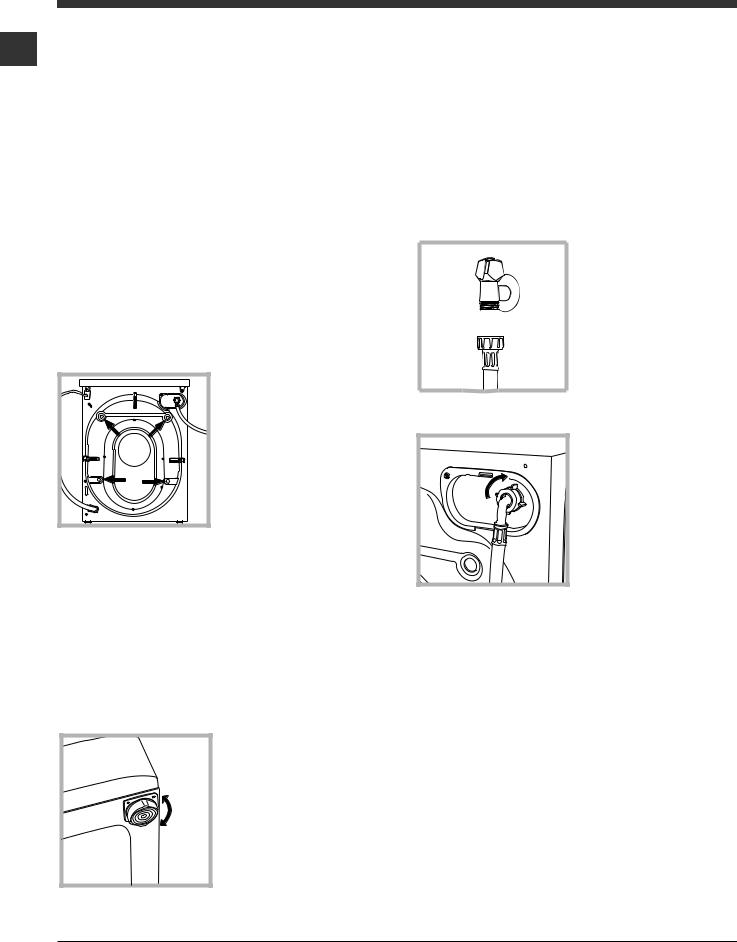
Installation
! This instruction manual should be kept in a GB safe place for future reference. If the washing machine is sold, transferred or moved, make sure that the instruction manual remains with the machine so that the new owner is able to
familiarise himself/herself with its operation and features.
! Read these instructions carefully: they contain vital information relating to the safe installation and operation of the appliance.
Unpacking and levelling
Unpacking
1.Remove the washing machine from its packaging.
2.Make sure that the washing machine has not been damaged during the transportation process. If it has been damaged, contact the retailer and do not proceed any further with the installation process.
3.Remove the 4 pro-
tective screws (used during transportation) and the rubber washer with the corresponding spacer, located on the rear part of the appliance (see figure).
4.Close off the holes using the plastic plugs provided.
5.Keep all the parts in a safe place: you will need them again if the washing machine needs to be moved to another location.
! Packaging materials should not be used as toys for children.
Levelling
1. Install the washing machine on a flat sturdy floor, without resting it up against walls, furniture cabinets or anything else.
2. If the floor is not perfectly level, compensate for any unevenness by tightening or loosening the adjustable front feet (see figure); the angle of inclination, measured in relation to the worktop, must not exceed 2°.
Levelling the machine correctly will provide it with stability, help to avoid vibrations and excessive noise and prevent it from shifting
while it is operating. If it is placed on carpet or a rug, adjust the feet in such a way as to allow a sufficient ventilation space underneath the washing machine.
Connecting the electricity and water supplies
Connecting the water inlet hose
1. Connect the inlet hose by screwing it to a cold water tap using a 3/4 gas threaded connection (see figure).
Before performing the connection, allow the water to run freely until it is perfectly clear.
2. Connect the inlet hose to the washing machine by screwing it onto the corresponding water inlet of the appliance, which is situated on the top right-hand side of the rear part of the appliance (see figure).
3. Make sure that the hose is not folded over or bent.
!The water pressure at the tap must fall within the range of values indicated in the Technical data table (see next page).
!If the inlet hose is not long enough, contact a specialised shop or an authorised technician.
!Never use second-hand hoses.
!Use the ones supplied with the machine.
2

Connecting the drain hose
65 - 100 cm |
Connect the drain hose, without bending it, to a drain duct or a wall drain situated between 65 and 100 cm from the floor;
alternatively, placed it over the edge of a basin, sink or tub, fastening the duct supplied to the tap (see figure). The free end of the hose should not be underwater.
! We advise against the use of hose extensions; if it is absolutely necessary, the extension must have the same diameter as the original hose and must not exceed 150 cm in length.
Electrical connections
Before plugging the appliance into the electricity socket, make sure that:
•the socket is earthed and complies with all applicable laws;
•the socket is able to withstand the maximum power load of the appliance as indicated in the Technical data table (see opposite);
•the power supply voltage falls within the values indicated in the Technical data table (see
opposite);
• the socket is compatible with the plug of the washing machine. If this is not the case, replace the socket or the plug.
!The washing machine must not be installed outdoors, even in covered areas. It is extremely dangerous to leave the appliance exposed to rain, storms and other weather conditions.
!When the washing machine has been installed, the electricity socket must remain within easy reach.
! Do not use extension cords or multiple sockets. GB
!The cable should not be bent or compressed.
!The power supply cable must only be replaced by authorised technicians.
Warning! The company shall not be held responsible in the event that these standards are not observed.
The first wash cycle
Once the appliance has been installed, and before you use it for the first time, run a wash cycle with detergent and no laundry, using the wash cycle “Auto Clean” (see “Cleaning the washing machine”).
Technical data
Model |
XWA 71483 |
|
|
|
|
|
width 59.5 cm |
|
Dimensions |
height 85 cm |
|
|
depth 54 cm |
|
Capacity |
from 1 to 7 kg |
|
Electrical |
please refer to the technical |
|
data plate fixed to the ma- |
||
connections |
||
chine |
||
|
maximum pressure |
|
Water |
1 MPa (10 bar) |
|
minimum pressure |
||
connections |
||
0.05 MPa (0.5 bar) |
||
|
drum capacity 52 litres |
|
Spin speed |
up to 1400 rotations per minute |
|
|
|
|
Test wash |
|
|
cycles in |
Programme 8: |
|
accordan- |
||
ce with |
Cotton Standard 60°. |
|
directives |
Programme 9: |
|
1061/2010 |
Cotton Standard 40°. |
|
and |
|
|
1015/2010 |
|
This appliance conforms to the following EC Directives:
-2004/108/EC (Electromagnetic Compatibility)
-2006/95/EC (Low Voltage)
- 2012/19/EU
3
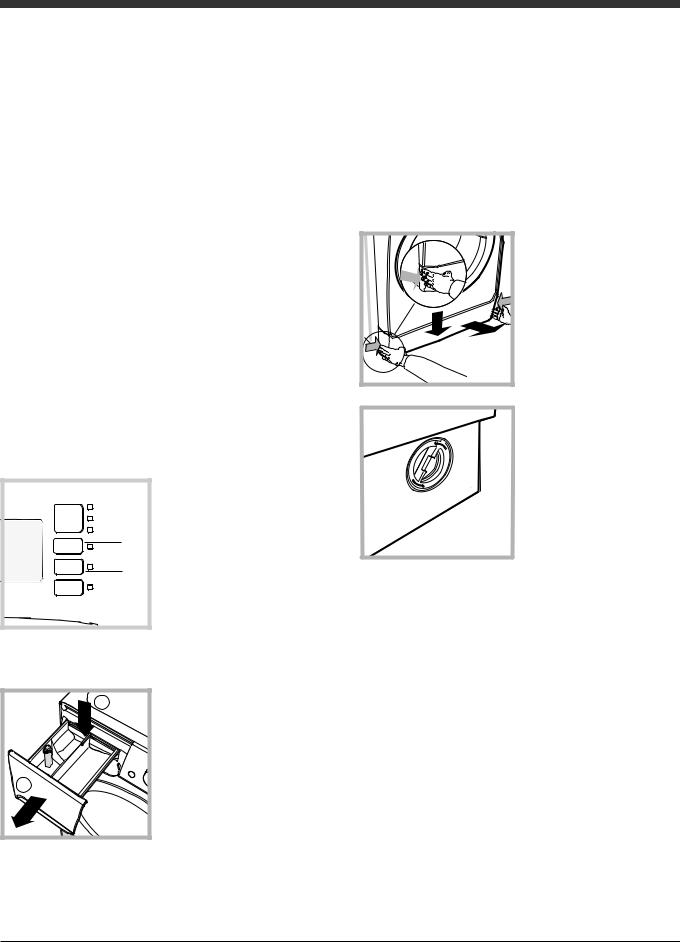
Care and maintenance
|
Cutting off the water and electricity |
|
GB |
||
supplies |
||
|
• Turn off the water tap after every wash cycle. |
|
|
Thiswilllimitwearonthehydraulicsysteminside |
|
|
the washing machine and help to prevent leaks. |
|
|
• Unplug the washing machine when cleaning it |
|
|
and during all maintenance work. |
Cleaning the washing machine
•The outer parts and rubber components of the appliance can be cleaned using a soft cloth soaked in lukewarm soapy water. Do not use solvents or abrasives.
•The washing machine has a “Auto Clean” programme for its internal parts that must be
run with no load in the drum.
For maximum performance you may want to use either the detergent (i.e. a quantity 10% the quantity specified for lightly-soiled garments) or special additives to clean the washing machine. We recommend running a cleaning programme every 40 wash cycles. To start the programme press buttons A and B simultaneously for 5 seconds (see figure). The programme will start automatically and
will last approximately 70 minutes. To stop the cycle press the START/PAUSE button.
A
B
Cleaning the detergent dispenser drawer
1 |
2 |
To remove the drawer, press lever (1) and pull the drawer outwards (2)
(see figure).
Wash it under running water; this procedure should be repeated frequently.
Cleaning the pump
The washing machine is fitted with a selfcleaning pump which does not require any maintenance. Sometimes, small items (such as coins or buttons) may fall into the protective pre-chamber at the base of the pump.
! Make sure the wash cycle has finished and unplug the appliance.
To access the pre-chamber:
1 |
|
2 |
3 |
|
1. Take off the cover panel on the front of the machine by first pressing it in the centre and then pushing downwards on both sides until you can remove it (see figures).
2. Unscrew the lid by rotating it anticlockwise (see figure): a little water may trickle out. This is perfectly normal.
3.Clean the inside thoroughly.
4.Screw the lid back on.
5.Reposition the panel, making sure the hooks are securely in place before you push it onto the appliance.
Checking the water inlet hose
Check the inlet hose at least once a year. If there are any cracks, it should be replaced immediately: during the wash cycles, water pressure is very strong and a cracked hose could easily split open.
! Never use second-hand hoses.
Caring for the door and drum of your appliance
•Always leave the porthole door ajar in order to prevent unpleasant odours from forming.
4

Precautions and tips
! This washing machine was designed and constructed in accordance with international safety regulations. The following information is provided for safety reasons and must therefore be read carefully.
General safety
•This appliance was designed for domestic use only.
•This appliance can be used by children aged
from 8 years and above and persons with reduced physical, sensory or mental capabilities or lack of experience and knowledge if they have been given supervision or instruction concerning use of the appliance in a safe way and understand the hazards involved. Children shall not play with the appliance. Cleaning and user maintenance shall not be made by children without supervision.
•The washing machine must only be used by adults, in accordance with the instructions provided in this manual.
•Do not touch the machine when barefoot or with wet or damp hands or feet.
•Do not pull on the power supply cable when unplugging the appliance from the electricity socket. Hold the plug and pull.
•Do not open the detergent dispenser drawer while the machine is in operation.
•Do not touch the drained water as it may reach extremely high temperatures.
•Never force the porthole door. This could damage the safety lock mechanism designed to prevent accidental opening.
•If the appliance breaks down, do not under any circumstances access the internal mechanisms in an attempt to repair it yourself.
•Always keep children well away from the appliance while it is operating.
•The door can become quite hot during the wash cycle.
•If the appliance has to be moved, work in a group of two or three people and handle it with the utmost care. Never try to do this alone, because the appliance is very heavy.
•Before loading laundry into the washing machine, make sure the drum is empty.
Load balancing system
Before every spin cycle, to avoid excessive vibrations and to distribute the load in a uniform manner, the drum rotates continuously at a speed which is slightly greater than the washing rotation speed. If, after several attempts, the load is not balanced correctly, the machine spins at a reduced spin speed. If the load is excessively unbalanced, the washing machine performs the distribution process instead of spinning. To encourage improved load distribution and balance, we recommend small and large garments are mixed in the load.
Disposal |
GB |
|
•Disposing of the packaging materials: observe local regulations so that the packaging may be re-used.
•The European Directive 2012/19/EU on Waste Electrical and Electronic Equipment, requires that old household electrical appliances must not be disposed of in the normal unsorted municipal waste stream. Old appliances must be collected separately in order to optimise the recovery and recycling of the materials they contain and reduce the impact on human health and the environment. The crossed out “wheeled bin” symbol on the product reminds you of your obligation, that when you dispose of the appliance it must be separately collected.
Consumers should contact their local authority or retailer for information concerning the correct disposal of their old appliance.
5
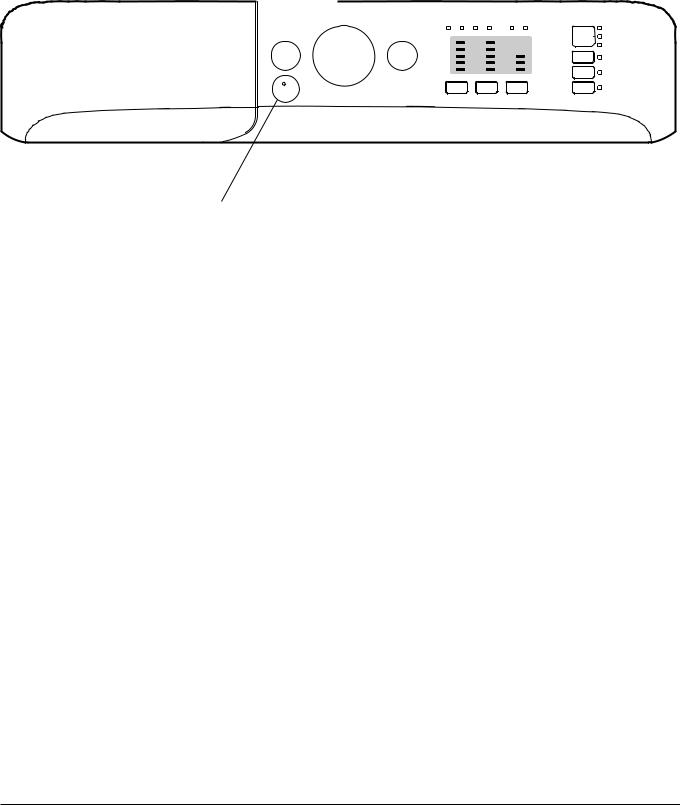
Description of the washing machine and starting a wash cycle
|
|
|
|
|
|
|
|
|
|
|
|
|
|
|
|
|
|
Control panel |
|
|
|
|
|
|
|
|
|
|
|
|
|
GB |
|
|
WASH CYCLE PROGRESS |
FUNCTION |
|||||||||||
|
|
|
|
|
|||||||||||
|
|
|
|
|
|
indicator lights |
|
buttons with |
|||||||
|
|
|
|
|
|
||||||||||
|
|
|
|
|
|
|
|
|
|
|
|
|
|
indicator lights |
|
|
|
ON/OFF |
START/PAUSE |
|
|
|
|
|
|
|
DOOR |
|
|
||
|
|
|
|
|
|
|
|
|
|
|
|||||
|
|
|
|
|
|
|
|
|
|
|
|||||
|
|
button with indicator |
|
|
|
|
|
|
|
LOCKED |
|
|
|||
|
|
button |
|
light |
|
|
|
|
|
|
|
indicator light |
|
|
|
|
|
|
|
|
|
|
|
|
|
|
|
|
|
|
|
|
|
|
|
|
|
|
|
|
|
|
|
|
|
|
|
|
|
|
|
|
|
|
|
|
|
|
|
|
|
|
|
|
|
|
|
|
|
|
|
|
|
|
|
|
|
|
|
|
|
|
|
|
|
|
|
|
|
|
|
|
|
|
|
|
|
|
|
|
|
|
|
|
|
|
|
|
|
|
|
|
|
|
|
|
|
|
|
|
|
|
|
|
|
|
|
|
|
|
|
|
|
|
|
|
|
|
|
|
|
|
|
|
|
WASH CYCLE |
|
|
|
DELAY TIMER |
|
|
|
|
|
||
Detergent dispenser drawer |
TEMPERATURE |
|
|
|||
|
|
knob |
button |
|
|
button |
|
|
|
|
|
|
|
|
PUSH & WASH |
SPIN |
|
|
||
|
button |
|
|
|||
|
button |
|
|
|
||
|
|
|
|
|
|
|
Detergent dispenser drawer: used to dispense detergents and washing additives (see “Detergents and laundry”).
ON/OFF button: switches the washing machine on and off.
PUSH & WASH button: (see “Wash cycles”).
WASH CYCLE knob: programmes the wash cycles. During the wash cycle, the knob does not move.
FUNCTION buttons with indicator light: used to select the available functions. The indicator light corresponding to the selected function will remain lit.
TEMPERATURE button: sets the temperature or the cold wash cycle (see “Personalisation”).
SPIN button: sets the spin speed or exclude the spin cycle completely (see “Personalisation”).
DELAY TIMER button: delays the start of the wash cycle by up to 9 hours.
Press the button repeatedly until the indicator light corresponding to the desired delay time turns on.
When the button is pressed for the fourth time, the option will be deactivated.
N.B.: once the START/PAUSE button has been pressed, the delay time can only be modified by decreasing it until the set programme is launched.
! This option is available on all programmes.
WASH CYCLE PROGRESS indicator lights: used to monitor the progress of the wash cycle.
The illuminated indicator light shows which phase is in progress.
DOOR LOCKED indicator light: indicates whether the door may be opened or not (see next page).
START/PAUSE button with indicator light: starts or temporarily interrupts the wash cycles.
N.B. To pause the wash cycle in progress, press this button; the corresponding indicator light will flash orange, while the indicator light for the current wash cycle phase will remain lit in a fixed manner. If the DOOR LOCKED  indicator light is switched off, the door may be opened (wait approximately 3 minutes).
indicator light is switched off, the door may be opened (wait approximately 3 minutes).
To start the wash cycle from the point at which it was interrupted, press this button again.
Standby mode
This washing machine, in compliance with new energy saving regulations, is fitted with an automatic standby system which is enabled after about 30 minutes if no activity is detected. Press the ON-OFF button briefly and wait for the machine to start up again.
6

Indicator lights
The indicator lights provide important information. This is what they can tell you:
Delayed start
If the DELAY TIMER function has been activated (see “Personalisation”), after the wash cycle has been started the indicator light corresponding to the selected delay period will begin to flash:
As time passes, the remaining delay will be displayed and the corresponding indicator light will flash:
The set programme will start once the selected time delay has expired.
Starting a wash cycle
Rapid programming
1.LOAD THE LAUNDRY. Open the porthole door. Load the laundry, making sure you do not exceed the maximum load value indicated in the table of programmes and wash cycles on the following page.
2.ADD THE DETERGENT. Pull out the detergent dispenser drawer and pour the detergent into the relevant compartments as described in “Detergents and laundry”.
3.CLOSE THE DOOR.
4.Press the “PUSH & WASH” button to start the wash programme.
Traditional programming
1. Turn the washing machine on by pressing the ON/OFF button. All the indicator lights will turn on for a few seconds, then only the indicator lights relative to the selected programme settings will remain lit and the START/PAUSE indicator light will flash.
Wash cycle phase indicator lights
Once the desired wash cycle has been selected and has be- GB gun, the indicator lights switch on one by one to indicate which
phase of the cycle is currently in progress.
Wash
Rinse
Spin
Drain
End of wash cycle END
Function buttons and corresponding indicator lights
When a function is selected, the corresponding indicator light will illuminate.
If the selected function is not compatible with the programmed wash cycle, the corresponding indicator light will flash and the function will not be activated.
If the selected option is not compatible with another previously selected option, the indicator light will flash accompanied by a buzzer (3 beeps), and only the latter option will be activated; the indicator light corresponding to the activated option will turn on
 Door locked indicator light
Door locked indicator light
When the indicator light is on, the porthole door is locked to prevent it from being opened; make sure the indicator light is off before opening the door (wait approximately 3 minutes).
To open the door during a running wash cycle, press the START/PAUSE button; the door may be opened once the DOOR LOCKED indicator light turns off.
2.Load the laundry and close the door.
3.Set the WASH CYCLE knob to the desired programme.
4.Set the washing temperature (see “Personalisation”).
5.Set the spin speed (see “Personalisation”).
6.Measure out the detergent and washing additives (see “Detergents and laundry”).
7.Select the desired functions.
8.Start the wash cycle by pressing the START/PAUSE button and the corresponding indicator light will remain lit in a fixed manner in green. To cancel the set wash cycle, pause the machine by pressing the START/PAUSE button and select a new cycle.
9.At the end of the wash cycle the END indicator light will switch on. The door can be opened once the DOOR
LOCK  indicator light turns off (wait approximately 3 minutes). Take out your laundry and leave the appliance door ajar to make sure the drum dries completely. Switch the washing machine off by pressing the ON/OFF button.
indicator light turns off (wait approximately 3 minutes). Take out your laundry and leave the appliance door ajar to make sure the drum dries completely. Switch the washing machine off by pressing the ON/OFF button.
7
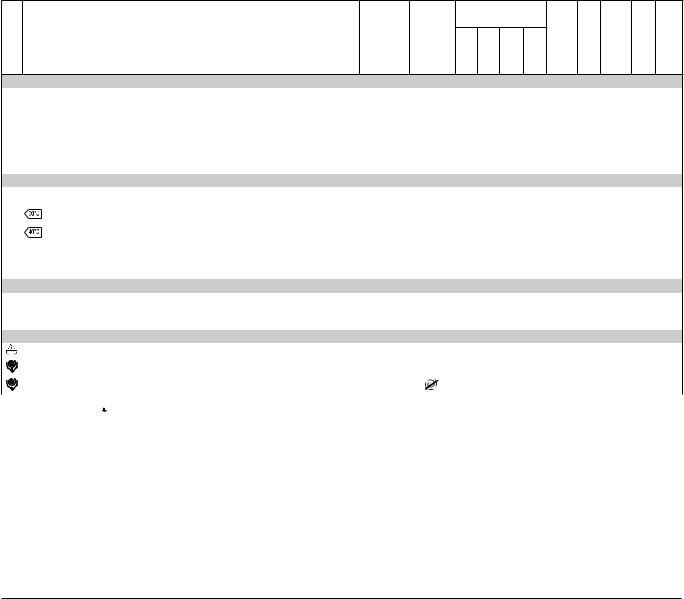
Wash cycles
|
|
|
|
|
Push & Wash |
||
GB |
|||
This function allows for starting a wash cycle even when the machine is switched off without having to press the ON/OFF |
|||
|
|||
|
button in advance, or after switching on the machine, without having activated any button and/or selector (otherwise, the |
||
|
Push & Wash function will be deactivated). To start the Push & Wash cycle press and hold the relative button for 2 seconds. |
||
|
The lit indicator light indicates that the cycle has started. This wash cycle is ideal for cotton or synthetic fabrics, as it washes |
||
|
at a temperature of 30° and a maximum spin speed of 1200 rpm. Maximum load 3,5 kg. (Cycle duration 50’). |
||
How does it work?
1.Load the laundry (cotton and/or synthetic garments) and close the door.
2.Pour the detergent and additives.
3.Start the programme by pressing and holding the Push & Wash button for 2 seconds. The relative indicator light turns green and the door will lock (the DOOR LOCKED symbol turns on).
N.B.: starting the wash cycle through the Push & Wash button activates an automatic non-customisable cycle recommended for cotton and synthetic fabrics. This programme does not allow for setting any additional options.
To open the door while an automatic cycle is under way, press the START/PAUSE button; if the DOOR LOCKED symbol is switched off the door may be opened. Press the START/PAUSE button again to restart the wash cycle from the point at which it was interrupted.
4.Once the programme is finished, the END indicator light turns on.
Table of wash cycles
Wash cycles
Description of the wash cycle
Max. Max. temp. speed (°C) (rpm)
Detergents
Prewash |
Wash |
softener |
Bleach |
|
|
Fabric |
|
loadMax.(kg) |
dampness |
consumption |
waterTotal lt |
durationCycle |
|
|
% |
|
|
|
|
|
Residual |
Energy |
kWh |
|
|
Special
1 |
Sport |
30° |
600 |
- |
|
|
- |
3,5 |
- |
- |
- |
55’ |
2 |
Dark |
30° |
800 |
- |
|
|
- |
4 |
- |
- |
- |
70’ |
3 |
Anti-odour (Cotton) |
60° |
1000 |
- |
|
|
- |
3,5 |
- |
- |
- |
110’ |
3 |
Anti-odour (Synthetic) |
40° |
1000 |
- |
|
|
- |
3,5 |
- |
- |
- |
100’ |
4 |
Delicate |
30° |
0 |
- |
|
|
- |
1 |
- |
- |
- |
80’ |
5 |
Wool: for wool, cashmere, etc. |
40° |
800 |
- |
|
|
- |
1,5 |
- |
- |
- |
70’ |
6 |
Duvet: for down-stuffed garments. |
30° |
1000 |
- |
|
|
- |
2 |
- |
- |
- |
110’ |
|
Standard |
|
|
|
|
|
|
|
|
|
|
|
7 |
Cottons with Pre-wash: extremely soiled whites. |
90° |
1400 |
|
|
|
- |
7 |
53 |
2,15 |
86 |
170’ |
8 |
Cotton Standard 60° (1): heavily soiled whites and resistant colours. |
60° |
1400 |
- |
|
|
- |
7 |
53 |
0,94 |
52,5 |
160’ |
(Max. 90°) |
||||||||||||
9 |
Cotton Standard 40° (2): lightly soiled whites and delicate colours. |
40° |
1400 |
- |
|
|
- |
7 |
53 |
0,93 |
77 |
140’ |
10 |
Synthetic: heavily soiled resistant colours. |
60° |
800 |
- |
|
|
- |
3,5 |
46 |
0,79 |
46 |
110’ |
10 |
Synthetic (3): lightly soiled resistant colours. |
40° |
800 |
- |
|
|
- |
3,5 |
46 |
0,56 |
46 |
100’ |
11 |
Coloured |
40° |
1400 |
- |
|
|
- |
7 |
53 |
0,89 |
70 |
100’ |
|
Eco & Rapid |
|
|
|
|
|
|
|
|
|
|
|
12 |
Cotton Standard 20°: lightly soiled whites and delicate colours. |
20° |
1400 |
- |
|
|
- |
7 |
- |
- |
- |
170’ |
13 |
20’ Refresh |
20° |
800 |
- |
|
|
- |
1,5 |
- |
- |
- |
20’ |
14 |
Rapid 60’ |
60° |
1000 |
- |
|
|
- |
7 |
- |
- |
- |
60’ |
|
Partials |
|
|
|
|
|
|
|
|
|
|
|
|
Rinse/Bleach |
- |
1400 |
- |
- |
|
|
7 |
- |
- |
- |
50’ |
|
Spin + Drain |
- |
1400 |
- |
- |
- |
- |
7 |
- |
- |
- |
10’ |
|
|
|
|
|
|
|
|
|
|
|
|
|
|
Drain only * |
- |
|
- |
- |
- |
- |
7 |
- |
- |
- |
3’ |
|
|
|
|
|
|
|
|
|
|
|
|
|
* If you select programme 
 and exclude the spin cycle, the machine will drain only.
and exclude the spin cycle, the machine will drain only.
The length of cycle shown on the display or in this booklet is an estimation only and is calculated assuming standard working conditions. The actual duration can vary according to factors such as water temperature and pressure, the amount of detergent used, the amount and type of load inserted, load balancing and any wash options selected.
1) Test wash cycle in compliance with directive 1061/2010: set wash cycle 8 with a temperature of 60°C.
This cycle is designed for cotton loads with a normal soil level and is the most efficient in terms of both electricity and water consumption; it should be used for garments which can be washed at 60°C. The actual washing temperature may differ from the indicated value.
2) Test wash cycle in compliance with directive 1061/2010: set wash cycle 9 with a temperature of 40°C.
This cycle is designed for cotton loads with a normal soil level and is the most efficient in terms of both electricity and water consumption; it should be used for garments which can be washed at 40°C. The actual washing temperature may differ from the indicated value.
For all Test Institutes:
2)Long wash cycle for cottons: set wash cycle 9 with a temperature of 40°C.
3)Synthetic program along: set wash cycle 10 with a temperature of 40°C.
8

Personalisation
|
|
|
|
|
Setting the temperature |
|
|||
GB |
||||
Press the TEMPERATURE button to set the wash temperature (see Table of wash cycles). |
||||
|
||||
The temperature may be lowered, or even set to a cold wash . The washing machine will automatically prevent you from |
|
|||
selecting a temperature which is higher than the maximum value set for each wash cycle. |
|
|||
! Exception: if the 8 programme is selected, the temperature can be increased up to a value of 90°C. |
|
|||
Setting the spin speed |
|
|||
Press the SPIN SPEED button to set the spin speed for the selected wash cycle. |
|
|||
The maximum spin speeds available for each wash cycle are as follows: |
|
|||
Wash cycles |
Maximum spin speed |
|
||
Cottons |
1400 rpm |
|
||
Synthetics |
800 rpm |
|
||
Wool |
800 rpm |
|
||
The spin speed may be lowered, or the spin cycle can be excluded altogether by selecting the symbol  .
.
The washing machine will automatically prevent you from selecting a spin speed which is higher than the maximum speed set for each wash cycle.
Functions
The various wash functions available with this washing machine will help to achieve the desired results, every time. To activate the functions:
1.Press the button corresponding to the desired function;
2.the function is enabled when the corresponding indicator light is illuminated.
Note: If the indicator light flashes rapidly, this signals that this particular function may not be selected in conjunction with the selected wash cycle.
 Stain removal
Stain removal
This option allows for selecting the type of dirt so as to optimally adjust the cycle for removing the stains. The following types of dirt can be selected:
- Food, for stains caused by foodstuffs and beverages, for example.
Food, for stains caused by foodstuffs and beverages, for example.
- Work, for grease and ink stains, for example.
Work, for grease and ink stains, for example.
- Outdoor, for mud and grass stains, for example.
!The wash cycle duration varies according to the type of selected dirt.
!It cannot be used in conjunction with wash cycles 1-2-3-4-5-6-7-11-12-13-14- -
-
 .
.
 Fast Forward
Fast Forward
During a wash programme and under certain conditions, pressing this button allows for ending the wash programme after only 20’ if necessary, by performing a brief rinse cycle followed by a spin cycle at maximum 800 rpm or lower, if reduced manually during the programme customisation phase. In this case, washing and rinsing performance will be reduced. After pressing the button, the relative indicator light turns on together with the indicator light of the rinse phase. If the selected temperature is equal to 40° and/or the button is pressed during the initial phase of the programme, the “Fast Forward” option lasts longer so that the detergent can dissolve properly and avoid damaging the fabrics. In this case, the rinse phase indicator light flashes while the wash indicator light remains fixed until the necessary activation conditions are fulfilled. If less than 20’ remain of the wash programme, the option will be disabled.
! It cannot be used in conjunction with wash cycles 2-4-5-6-13-14- -
-
 .
.
 Easy iron
Easy iron
By selecting this function, the wash and spin cycles will be modified in order to reduce the formation of creases. At the end of the cycle the washing machine will perform slow rotations of the drum, while the EASY IRON and START/PAUSE indicator lights will flash and the END led will remain lit in a fixed manner. To end the cycle, press the START/PAUSE button or the EASY IRON button.
! It cannot be used in conjunction with wash cycles 1-3-5-13-14- -
-
 .
.
 Extra Rinse
Extra Rinse
By selecting this option, the efficiency of the rinse is increased and optimal detergent removal is guaranteed. It is particularly useful for sensitive skin.
! It cannot be used in conjunction with wash cycles 2-4-13-14-
 .
.
9
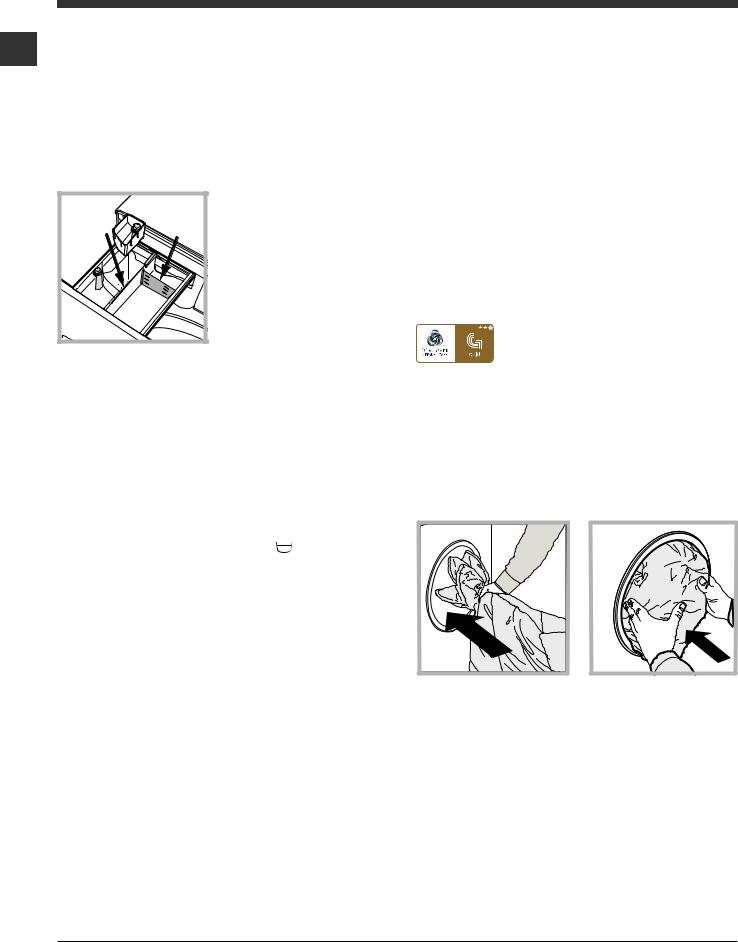
Detergents and laundry
Detergent dispenser drawer
GB Successful washing results also depend on the correct dose of detergent: adding too much detergent will not necessarily result in a more efficient wash, and may in fact cause build up on the inside of your appliance and contribute to environmental pollution.
!Do not use hand washing detergents because these create too much foam.
!Use powder detergent for white cotton garments, for prewashing, and for washing at temperatures over 60°C.
!Follow the instructions given on the detergent packaging.
|
|
|
Open the detergent dispen- |
|
|
|
ser drawer and pour in the |
B 4 |
|
A |
detergent or washing additi- |
|
ve, as follows. |
||
|
|
|
|
|
1 |
|
Compartment 1: Pre-wa- |
3 |
|
|
sh detergent (powder) |
2 |
|
Before pouring in the deter- |
|
|
|
gent, make sure that extra |
|
|
|
|
compartment 4 has been |
|
|
|
removed. |
Compartment 2: Washing detergent (powder or liquid)
If liquid detergent is used, it is recommended that the removable plastic partition A (supplied) be used for proper dosage. If powder detergent is used, place the partition into slot B.
Compartment 3: Additives (fabric softeners, etc.)
The fabric softener must not exceed the “max” level indicated on the central pin.
Extra compartment 4: Bleach
Bleach cycle
Insert the additional compartment 4 (provided) into compartment 1. In pouring the bleach do not exceed the “max” level indicated on the central pin.
Perform bleaching by pouring the bleach into additional compartment 4 and set the programme 

 .
.
! Traditional bleach should be used on resistant white fabrics, and delicate bleach for coloured and synthetics fabrics and for wool.
Preparing the laundry
•Divide the laundry according to:
-the type of fabric/the symbol on the label
-the colours: separate coloured garments from whites.
•Empty all garment pockets and check the buttons.
•Do not exceed the values listed in the “Table of wash cycles”, which refer to the weight of the laundry when dry.
How much does your laundry weigh?
1 sheet 400-500 g
1 pillow case 150-200 g
1 tablecloth 400-500 g
1 bathrobe 900-1.200 g
1 towel 150-250 g
Garments requiring special care
Sport (programme 1) is designed for washing lightly soiled sports clothing (tracksuits, shorts, etc.); for best results, we recommend not exceeding the maximum load indicated
in the “Table of wash cycles”. We recommend using liquid detergent, and adding the amount suitable for a half-load. Dark: use cycle 2 to wash dark-coloured garments. This programme is designed to maintain dark colours over time. We recommend using a liquid detergent for the best results when washing dark-coloured garments.
Anti-odour: use programme 3 for washing garments with bad odours (e.g. smoke, sweat, fried food). The programme is designed to remove bad odours while preserving the fabric fibres. Synthetics fabrics or mixed loads should be washed at 40°, and resistant cotton fabrics at 60°. Delicate: use programme 4 to wash very delicate garments. It is advisable to turn the garments inside out before washing them. For best results, use liquid detergent on delicate garments. For washing Silk items and Curtains, select the relevant cycle and activate the option  (in this case it will also be possible to enable the “Extra Rinse” option); the machine will end the cycle with the laundry soaked and the indicator light will flash. To drain the water so that the laundry can be removed, press the START/ PAUSE button ro the option
(in this case it will also be possible to enable the “Extra Rinse” option); the machine will end the cycle with the laundry soaked and the indicator light will flash. To drain the water so that the laundry can be removed, press the START/ PAUSE button ro the option  .
.
Wool: the wool wash cycle of this machine has been tested and approved by The Woolmark Company for the washing of wool containing garments labelled as “hand wash” provided that the garments are washed according to the instructions on the garment label and those issued by the manufacturer of this washing machine. (M1126)
In UK, Eire, Hong Kong and India the Woolmark trade mark is a Certification trade mark.
Duvet: to wash single duvets (the weight of which should not exceed 2 kg), cushions or clothes padded with goose down such as puffa jackets, use the special wash cycle number 6. We recommend that duvets are placed in the drum with their edges folded inwards (see figure) and that no more than ¾ of the total volume of the drum is used. To achieve the best results, we recommend that a liquid detergent is used and placed inside the detergent dispenser drawer.
Coloured: use this cycle 11 to wash bright coloured clothes. The programme is designed to maintain bright colours over time.
Cotton Standard 20° (programme 12) ideal for lightly soiled cotton loads. The effective performance levels achieved at cold temperatures, which are comparable to washing at 40°, are guaranteed by a mechanical action which operates at varying speed, with repeated and frequent peaks.
20’ Refresh (programme 13) ideal for refreshing and washing lightly soiled garments in a few minutes. It lasts just 20 minutes and therefore saves both time and energy. It can be used to wash different types of fabrics together (except for wool and silk), with a maximum load of 1.5 kg. Rapid 60’ (programme 14) is designed to wash moderately soiled resistant cotton garments at 60° in an hour, with good washing performance. For synthetic or mixed garments, we recommend lowering the temperature down to 40°.
10

Troubleshooting
|
|
|
|
Your washing machine could fail to work. Before contacting the Technical Assistance Centre (see “Assistance”), make sure |
|
||
GB |
|||
that the problem cannot be solved easily using the following list. |
|||
|
|||
|
|
|
|
Problem:
The washing machine does not switch on.
The wash cycle does not start.
The washing machine does not take in water (the indicator light for the first wash cycle stage flashes rapidly).
The washing machine continuously takes in and drains water.
The washing machine does not drain or spin.
The washing machine vibrates a lot during the spin cycle.
The washing machine leaks.
The “Functions” indicator lights and the “start/pause” indicator light flash, while one of the “phase in progress” indicator lights and the “door locked” indicator light will remain lit in a fixed manner.
There is too much foam.
Push & Wash does not activate.
Possible causes / Solutions:
•The appliance is not plugged into the socket fully, or is not making contact.
•There is no power in the house.
•The washing machine door is not closed properly.
•The ON/OFF button has not been pressed.
•The START/PAUSE button has not been pressed.
•The water tap has not been opened.
•A delayed start has been set (see “Personalisation”).
•The water inlet hose is not connected to the tap.
•The hose is bent.
•The water tap has not been opened.
•There is no water supply in the house.
•The pressure is too low.
•The START/PAUSE button has not been pressed.
•The drain hose is not fitted at a height between 65 and 100 cm from the floor (see “Installation”).
•The free end of the hose is under water (see “Installation”).
•The wall drainage system is not fitted with a breather pipe.
If the problem persists even after these checks, turn off the water tap, switch the appliance off and contact the Assistance Service. If the dwelling is on one of the upper floors of a building, there may be problems relating to water drainage, causing the washing machine to fill with water and drain continuously. Special anti-draining valves are available in shops and help to avoid this inconvenience.
•The wash cycle does not include draining: some wash cycles require the drain phase to be started manually.
•The  function is enabled: to complete the wash cycle, press the START/ PAUSE button (“Personalisation”).
function is enabled: to complete the wash cycle, press the START/ PAUSE button (“Personalisation”).
•The drain hose is bent (see “Installation”).
•The drainage duct is clogged.
•The drum was not unlocked correctly during installation (see “Installation”).
•The washing machine is not level (see “Installation”).
•The washing machine is trapped between cabinets and walls (see “Installation”).
•The water inlet hose is not screwed on properly (see “Installation”).
•The detergent dispenser drawer is blocked (for cleaning instructions, see “Care and maintenance”).
•The drain hose is not fixed properly (see “Installation”).
•Switch off the machine and unplug it, wait for approximately 1 minute and then switch it back on again.
If the problem persists, contact the Technical Assistance Service.
•The detergent is not suitable for machine washing (it should display the text “for washing machines” or “hand and machine wash”, or the like).
•Too much detergent was used.
•After switching on the machine a control other than Push & Wash was activated. Switch the machine off and press the Push & Wash button.
The programme lasts a lot less that • The “Fast Forward” option was activated. expected.
11
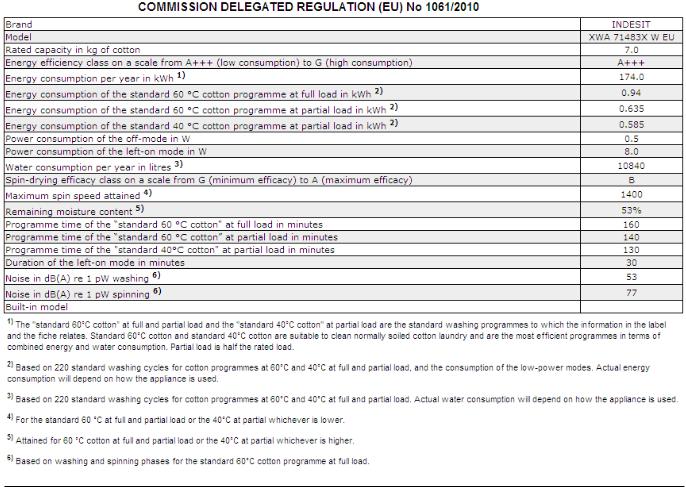
Service
|
|
|
|
|
|
Before calling for Assistance: |
|
GB |
|||
|
• Check whether you can solve the problem alone (see “Troubleshooting”); |
||
|
|
• Restart the programme to check whether the problem has been solved; |
|
|
|||
|
|
• If this is not the case, contact an authorised Technical Assistance Centre using the telephone number provided on the |
|
|
|
guarantee certificate. |
|
|
|
! Always request the assistance of authorised technicians. |
Have the following information to hand:
•the type of problem;
•the appliance model (Mod.);
•the serial number (S/N).
This information can be found on the data plate applied to the rear of the washing machine, and can also be found on the front of the appliance by opening the door.
12

Mode d’emploi
FR
Français
XWA 71483
LAVE-LINGE
Sommaire |
FR |
|
Installation, 14-15
Déballage et mise à niveau
Raccordements eau et électricité
Premier cycle de lavage
Caractéristiques techniques
Entretien et soin, 16
Coupure de l’arrivée d’eau et du courant
Nettoyage du lave-linge
Nettoyage du tiroir à produits lessiviels
Entretien du hublot et du tambour
Nettoyage de la pompe
Contrôle du tuyau d’arrivée de l’eau
Précautions et conseils, 17
Sécurité générale
Système d’équilibrage de la charge
Mise au rebut
Description du lave-linge et démarrage d’un programme, 18-19
Bandeau de commandes Voyants
Démarrage d’un programme
Programmes, 20
Push & Wash
Tableau des programmes
Personnalisations, 21
Sélection de la température
Sélection de l’essorage
Options
Produits lessiviels et linge, 22
Tiroir à produits lessiviels
Cycle blanchissage
Triage du linge
Linge ou vêtements particuliers
Anomalies et remèdes, 23
Assistance, 24
13

Installation
! Conserver ce mode d’emploi pour pouvoir FR le consulter à tout moment. En cas de vente,
de cession ou de déménagement, veiller à ce qu’il suive toujours le lave-linge pour que son nouveau propriétaire soit informé sur son mode de optionnement et puisse profiter des conseils correspondants.
! Lire attentivement les instructions: elles fournissent des conseils importants sur l’installation, l’utilisation et la sécurité de l’appareil.
Déballage et mise à niveau
Déballage
1.Déballer le lave-linge.
2.Contrôler que le lave-linge n’a pas été endommagé pendant le transport. S’il est abîmé, ne pas le raccorder et contacter le vendeur.
3.Enlever les 4 vis
de protection servant au transport, le caoutchouc et la cale, placés dans la partie arrière (voir figure).
4.Boucher les trous à l’aide des bouchons plastique fournis.
5.Conserver toutes ces pièces: il faudra les remonter en cas de transport du lave-linge. ! Les pièces d’emballage ne sont pas des jouets pour enfants.
Mise à niveau
1. Installer le lave-linge sur un sol plat et rigide, sans l’appuyer contre des murs, des meubles ou autre.
2. Si le sol n’est pas parfaitement horizontal, visser ou dévisser les pieds de réglage avant (voir figure) pour niveler l’appareil; son angle d’inclinaison, mesuré sur le plan de travail, ne doit pas dépasser 2°.
Une bonne mise à niveau garantit la stabilité de l’appareil et évite qu’il y ait des vibrations, du bruit et des déplacements en cours de optionnement. Si la machine est posée sur de la moquette ou un tapis, régler les pieds de manière à ce qu’il y ait suffisamment d’espace pour assurer une bonne ventilation.
Raccordements eau et électricité
Raccordement du tuyau d’arrivée de l’eau
1. Reliez le tuyau d’alimentation en le vissant à un robinet d’eau froide à embout fileté 3/4 gaz (voir figure).
Faire couler l’eau jusqu’à ce qu’elle soit limpide et sans impuretés avant de raccorder.
2. Raccorder le tuyau d’arrivée de l’eau au lave-linge en le vissant à la prise d’eau prévue, dans la partie arrière en haut à droite (voir figure).
3. Attention à ce que le tuyau ne soit pas plié ou écrasé.
!La pression de l’eau doit être comprise entre les valeurs indiquées dans le tableau des Caractéristiques techniques (voir page ci-contre).
!Si la longueur du tuyau d’alimentation ne suffit pas, s’adresser à un magasin spécialisé ou à un technicien agréé.
!N’utiliser que des tuyaux neufs.
!Utiliser ceux qui sont fournis avec l’appareil.
14

Raccordement du tuyau de vidange
65 - 100 cm |
Raccorder le tuyau d’évacuation, sans le plier, à un conduit d’évacuation ou à une évacuation murale placés à une
distance du sol comprise entre 65 et 100 cm ;
ou bien l’accrocher à un évier ou à une baignoire, dans ce cas, fixer le support en plastique fourni avec l’appareil au robinet (voir figure). L’extrémité libre du tuyau d’évacuation ne doit pas être plongée dans l’eau.
! L’utilisation d’un tuyau de rallonge est absolument déconseillée mais si on ne peut faire autrement, il faut absolument qu’il ait le même diamètre que le tuyau original et sa longueur ne doit pas dépasser 150 cm.
Raccordement électrique
Avant de brancher la fiche dans la prise de courant, s’assurer que :
•la prise est bien reliée à la terre et est conforme aux réglementations en vigueur;
•la prise est bien apte à supporter la puissance maximale de l’appareil indiquée dans le tableau des Caractéristiques techniques (voir ci-contre);
•la tension d’alimentation est bien comprise entre les valeurs figurant dans le tableau des Caractéristiques techniques (voir ci-contre);
•lapriseestbiencompatibleaveclafichedulavelinge. Autrement, remplacer la prise ou la fiche.
!Le lave-linge ne doit pas être installé dehors, même à l’abri, car il est très dangereux de le laisser exposé à la pluie et aux orages.
!Après installation du lave-linge, la prise de courant doit être facilement accessible.
!N’utiliser ni rallonges ni prises multiples.
! Le câble ne doit être ni plié ni trop écrasé. |
|
|
FR |
||
|
||
! Le câble d’alimentation ne doit être remplacé |
|
|
|
||
que par des techniciens agréés. |
|
|
Attention! Nous déclinons toute responsabilité |
|
|
en cas de non-respect des normes énumérées |
|
|
ci-dessus. |
|
Premier cycle de lavage
Avant la première mise en service de l’appareil, effectuer un cycle de lavage avec un produ-
it lessiviel mais sans linge et sélectionner le programme «AUTO NETTOYANT» (voir “Nettoyage du lave-linge”).
Caractéristiques techniques
Modèle |
XWA 71483 |
|||
|
|
|
|
|
|
|
|
largeur 59,5 cm |
|
Dimensions |
hauteur 85 cm |
|||
|
|
|
profondeur 54 cm |
|
Capacité |
de 1 à 7 kg |
|||
|
|
|
|
|
Raccorde- |
Voir la plaque signalétique |
|||
ments élec- |
||||
appliquée sur la machine |
||||
triques |
|
|||
Raccor- |
pression maximale |
|||
1 MPa (10 bar) |
||||
dements |
||||
pression minimale |
||||
hydrauli- |
||||
0,05 MPa (0,5 bar) |
||||
ques |
||||
capacité du tambour 52 litres |
||||
|
|
|
||
Vitesse |
jusqu’à 1400 tours minute |
|||
d’essorage |
||||
Programmes |
|
|||
de contrôle |
programme 8; |
|||
selon les |
Coton standard 60°C. |
|||
directives |
||||
programme 9; |
||||
1061/2010 |
||||
Coton standard 40 °C. |
||||
et |
|
|||
1015/2010 |
|
|||
|
|
|
Cet appareil est conforme |
|
|
|
|
aux Directives Communau- |
|
|
|
|
taires suivantes: |
|
|
|
|
- 2004/108/CE (Compatibili- |
|
|
|
|
té électromagnétique) |
|
|
|
|
- 2012/19/EU |
|
|
|
|
- 2006/95/CE (Basse Tension) |
|
|
|
|
||
|
|
|
||
15
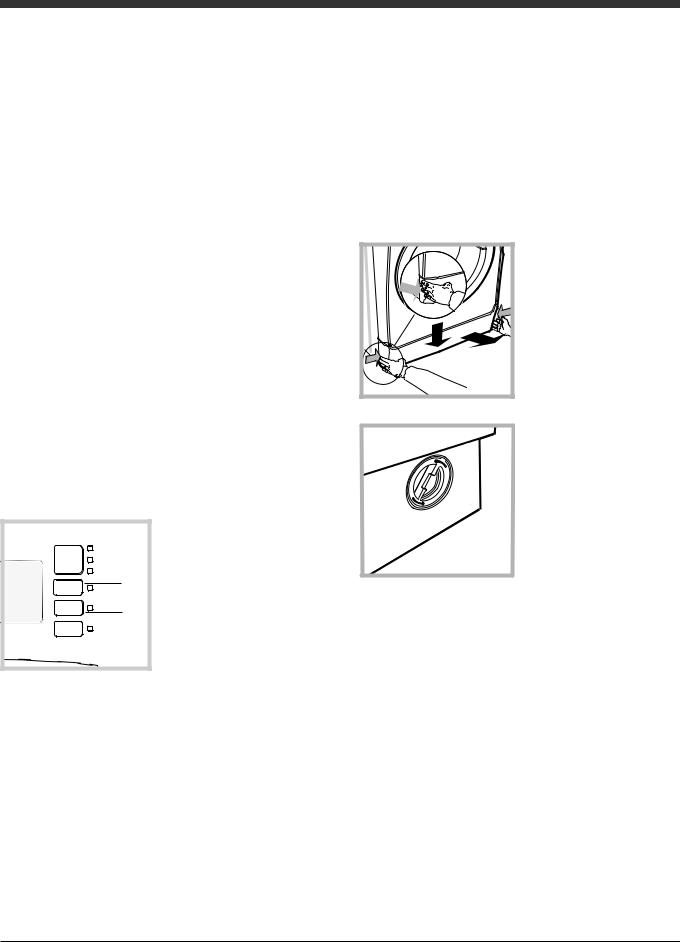
Entretien et soin
|
Coupure de l’arrivée d’eau et du |
|
FR |
||
courant |
||
|
• Fermer le robinet de l’eau après chaque |
|
|
lavage. Cela réduit l’usure de l’installation |
|
|
hydraulique du lave-linge et évite tout dan- |
|
|
ger de fuites. |
|
|
• Débrancher la fiche de la prise de courant |
|
|
lors de tout nettoyage du lave-linge et pen- |
|
|
dant tous les travaux d’entretien. |
Nettoyage du lave-linge
•Pour nettoyer l’extérieur et les parties en caoutchouc, utiliser un chiffon imbibé d’eau tiède et de savon. N’utiliser ni solvants ni abrasifs.
•Ce lave-linge est équipé d’un programme «AUTO NETTOYANT» des parties internes qui doit
être effectué tambour complètement vide. La lessive (dans une quantité égale à 10% de celle conseillée pour du linge peu sale) ou les additifs spéciaux pour le nettoyage du lavelinge, pourront être utilisés comme adjuvants dans le programme de lavage. Il est conseillé d’effectuer le programme de nettoyage tous les 40 cycles de lavage.
Pour activer le programme, appuyer simultanément sur les touches A et B pendant 5 secondes (voir figure). Le programme démarrera automatiquement et durera environ 70 minutes. Pour stopper le cycle, appuyer sur la touche START/PAUSE.
A
B
Nettoyage du tiroir à produits lessiviels
Pour sortir le tiroir, appuyer sur le levier (1) et tirer vers soi (2) (voir figure).
Le laver à l’eau courante ; effectuer cette opération assez souvent.
Entretien du hublot et du tambour
•Il faut toujours laisser le hublot entrouvert pour éviter la formation de mauvaise odeurs.
Nettoyage de la pompe
Le lave-linge est équipé d’une pompe autonettoyante qui n’exige aucune opération d’entretien. Il peut toutefois arriver que de menus objets (pièces de monnaie, boutons) tombent dans la préchambre qui protège la pompe, placée en bas de cette dernière.
! S’assurer que le cycle de lavage est bien terminé et débrancher la fiche.
Pour accéder à cette préchambre :
1 |
|
2 |
3 |
|
1. retirer le panneau situé à l’avant du lave-linge en appuyant vers le centre. Appuyer ensuite vers le bas de chaque côté et l’extraire (voir figures).
2. dévisser le couvercle en le tournant dans le sens inverse des aiguilles d’une montre (voir figure) : il est normal qu’un peu d’eau s’écoule;
3.nettoyer soigneusement l’intérieur;
4.revisser le couvercle;
5.remonter le panneau en veillant à bien enfiler les crochets dans les fentes prévues avant de le pousser contre l’appareil.
Contrôle du tuyau d’arrivée de l’eau
Contrôler le tuyau d’alimentation au moins une fois par an. Procéder à son remplacement en cas de craquèlements et de fissures : car les fortes pressions subies pendant le lavage pourraient provoquer des cassures.
! N’utiliser que des tuyaux neufs.
16

Précautions et conseils
! Ce lave-linge a été conçu et fabriqué conformément aux normes internationales de sécurité. Ces consignes sont fournies pour des raisons de sécurité, il faut les lire attentivement.
Sécurité générale
•Cet appareil est conçu pour un usage domestique.
•Cet appareil peut être utilisé par les enfants à
partir de 8 ans et par les personnes dont les capacités physiques, sensorielles ou mentales sont réduites ou qui ne disposent pas des connaissances suffisantes, à condition qu’ils soient encadrés ou aient été formés de façon appropriée pour l’utilisation de l’appareil de façon sûre et en comprenant les dangers qui y sont liés. Les enfants ne doivent pas jouer avec l’appareil. L’entretien et le nettoyage ne doivent pas être effectués par les enfants sans surveillance.
•Ne jamais toucher l’appareil si l’on est pieds nus et si les mains sont mouillées ou humides.
•Ne jamais tirer sur le câble pour débrancher la fiche de la prise de courant.
•Ne pas ouvrir le tiroir à produits lessiviels si la machine est branchée.
•Ne pas toucher à l’eau de vidange, elle peut atteindre des températures très élevées.
•Ne pas forcer pour ouvrir le hublot: le verrouillage de sécurité qui protège contre les ouvertures accidentelles pourrait s’endommager.
•En cas de panne, éviter à tout prix d’accéder aux mécanismes internes pour tenter une réparation.
•Veiller à ce que les enfants ne s’approchent pas de l’appareil pendant son optionnement.
•Pendant le lavage, le hublot a tendance à se réchauffer.
•Deux ou trois personnes sont nécessaires pour déplacer l’appareil avec toutes les précautions nécessaires. Ne jamais le déplacer tout seul car il est très lourd.
•Avant d’introduire le linge, s’assurer que le tambour est bien vide.
Système d’équilibrage de la charge
Avant tout essorage, pour éviter toute vibration excessive et répartir le linge de façon uniforme, le lave-linge fait tourner le tambour à une vitesse légèrement supérieure
àla vitesse de lavage. Si au bout de plusieurs tentatives, la charge n’est toujours pas correctement équilibrée, l’appareil procède à un essorage à une vitesse inférieure
àla vitesse normalement prévue. En cas de déséquilibre excessif, le lave-linge préfère procéder à la répartition du linge plutôt qu’à son essorage. Pour une meilleure répartition de la charge et un bon équilibrage, nous conseillons de mélanger de grandes et petites pièces de linge.
Mise au rebut |
FR |
|
•Mise au rebut du matériel d’emballage: se conformer aux réglementations locales de manière à ce que les emballages puissent être recyclés.
•La Directive Européenne 2012/19/EU sur les Déchets des Equipements Electriques et Electroniques, exige que les appareils ménagers usagés ne soient pas jetés dans le flux normal des déchets municipaux. Les appareils usagés doivent être collectés séparément afin d’optimiser le taux de récupération et le recyclage des matériaux qui les composent et réduire l’impact sur la santé humaine et l’environnement.
Le symbole de la ‘’poubelle barrée’’ est apposée sur tous les produits pour rappeler les obligations de collecte séparée. Les consommateurs devront contacter les autorités locales ou leur revendeur concernant la démarche à suivre pour l’enlèvement de leur vieil appareil.
17
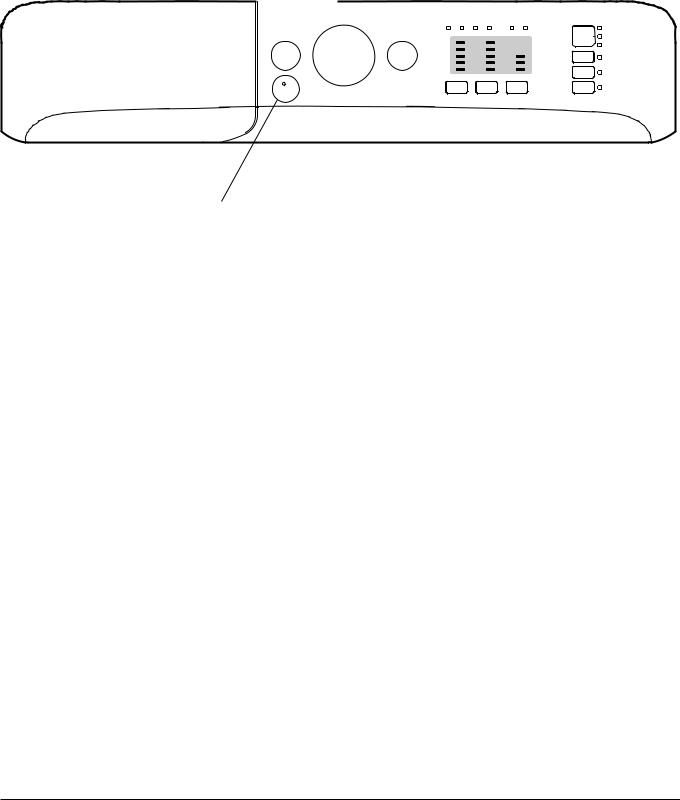
Description du lave-linge et démarrage d’un programme
|
|
|
|
|
|
|
|
|
|
|
|
|
|
|
|
|
|
|
Bandeau de commandes |
|
|
|
|
|
|
|
|
|
|
|
|
|
|
FR |
|
|
Voyants DÉROULEMENT |
|||||||||||||
|
|
|
|
|
||||||||||||
|
|
|
|
|
|
|||||||||||
|
|
|
|
|
|
CYCLE |
|
Touches avec |
||||||||
|
|
|
|
|
|
|
|
|
|
|
|
|
voyants OPTION |
|||
|
|
|
|
|
|
|
|
|
|
|
|
|
|
|
|
|
|
|
|
|
Touche avec voyant |
|
|
|
|
|
|
|
Voyant |
|
|||
|
|
|
|
|
|
|
|
|
|
|
|
|
||||
|
|
Touche ON/OFF |
|
|
|
|
|
|
|
HUBLOT |
|
|
||||
|
|
START/PAUSE |
|
|
|
|
|
|
|
|
||||||
|
|
|
|
|
|
|
|
|
|
|
|
|
VERROUILLÉ |
|
||
|
|
|
|
|
|
|
|
|
|
|
|
|
|
|
|
|
|
|
|
|
|
|
|
|
|
|
|
|
|
|
|
|
|
|
|
|
|
|
|
|
|
|
|
|
|
|
|
|
|
|
|
|
|
|
|
|
|
|
|
|
|
|
|
|
|
|
|
|
|
|
|
|
|
|
|
|
|
|
|
|
|
|
|
|
|
|
|
|
|
|
|
|
|
|
|
|
|
|
|
|
|
|
|
|
|
|
|
|
|
|
|
|
|
|
|
|
|
|
|
|
|
|
|
|
|
|
|
|
|
|
|
|
|
|
|
|
|
|
|
|
|
Touche |
|
|
|
|
|
|
|
|
|
Bouton |
|
|
|
DÉPART |
Tiroir à produits lessiviels |
|
|
|
|||
PROGRAMMES |
|
|
|
DIFFÉRÉ |
||
|
|
|
|
|
||
|
Touche |
|
Touche |
|
|
|
|
|
TEMPÉRATURE |
|
|
||
|
PUSH & WASH |
Touche |
||||
|
|
|
||||
|
|
|
|
|
ESSORAGE |
|
Tiroir à produits lessiviels: pour charger les produits lessiviels et les additifs (voir “Produits lessiviels et linge”).
Touche ON/OFF: pour allumer ou éteindre le lave-linge.
Touche PUSH & WASH: (voir “Programmes”).
Bouton PROGRAMMES: pour sélectionner les programmes. Pendant le programme, le bouton ne tournera pas.
Touches avec voyants OPTION: pour sélectionner les options disponibles. Le voyant correspondant à la option sélectionnée restera allumé.
Touche TEMPÉRATURE: pour sélectionner la température ou un lavage à froid (voir “Personnalisations”).
Touche ESSORAGE: pour sélectionner l’essorage ou le supprimer (voir “Personnalisations”).
Touche DÉPART DIFFÉRÉ: pour différer la mise en marche de votre machine jusqu’à 9 heures. Appuyer plusieurs fois de suite sur la touche jusqu’à ce que le voyant correspondant au retard souhaité s’allume. A la quatrième pression sur la touche, l’option se désactive.
N.B.: Après avoir appuyé sur la touche START/PAUSE, le retard programmé ne peut être modifié que pour le diminuer jusqu’à lancer le programme sélectionné.
! Il est activé avec tous les programmes.
Voyants DÉROULEMENT CYCLE: pour suivre le stade d’avancement du programme de lavage.
Le voyant allumé indique la phase de lavage en cours.
Voyant HUBLOT VERROUILLÉ: indique si la porte est verrouillée (voir page ci-contre).
Touche avec voyant START/PAUSE: pour démarrer les programmes ou les interrompre momentanément.
N.B.: pour effectuer une pause du lavage en cours, appuyer sur cette touche, le voyant correspondant se mettra à clignoter en orange tandis que celui de la phase en cours restera allumé fixe. Si le voyant HUBLOT VERROUILLÉ  est éteint, on peut ouvrir la porte (3 minutes environ).
est éteint, on peut ouvrir la porte (3 minutes environ).
Pour faire redémarrer le lavage exactement de l’endroit où il a été interrompu, appuyer une nouvelle fois sur la touche.
Stand-by
Ce lave-linge, conformément aux nouvelles normes en vigueur dans le domaine de l’économie d’énergie, est équipée d’un système d’extinction automatique (veille) activé après 30 minutes environ d’inutilisation. Appuyez brièvement sur la touche ON/OFF et attendre que la machine soit réactivée.
18

Voyants
Les voyants fournissent des informations importantes. Voilà ce qu’ils signalent:
Départ différé
Si la option “Départ différé” a été activée (voir “Personnalisations”), le voyant correspondant au temps sélectionné se mettra à clignoter, après avoir lancé le programme:
Au fur et à mesure que le temps passe, le temps restant est affiché avec clignotement du voyant correspondant.
Quand le retard sélectionné touche à sa fin le programme sélectionné démarre.
Voyants phase en cours
Une fois que le cycle de lavage sélectionné a démarré, FR les voyants s’allument progressivement pour indiquer son
stade d’avancement: Lavage
Rinçage
Essorage
Vidange
Fin de Lavage END
Touches options et voyants correspondants
La sélection d’une option entraîne l’allumage du voyant correspondant.
Si la option sélectionnée est incompatible avec le programme sélectionné, le voyant correspondant se met à clignoter et la option n’est pas activée.
Si la fonction sélectionnée est incompatible avec une autre précédemment sélectionnée, le voyant correspondant se met à clignoter, un signal sonore (3 bips) retentit et seule la deuxième fonction est activée, le voyant de l’option activée s’allume.
 Voyant hublot verrouillé
Voyant hublot verrouillé
Le voyant allumé indique que le hublot est verrouillé pour en empêcher l’ouverture. Attendre que le voyant cesse de clignoter avant d’ouvrir la porte (3 minutes environ).
Pour ouvrir le hublot tandis qu’un cycle est en cours, appuyer sur la touche START/PAUSE; si le voyant HUBLOT VERROUILLÉ est éteint, on peut ouvrir le hublot.
Démarrage d’un programme
Programmation rapide
1.CHARGER LE LINGE. Ouvrir la porte hublot. Charger le linge en faisant attention à ne pas dépasser la quantité indiquée dans le tableau des programmes de la page suivante.
2.DOSER LE PRODUIT LESSIVIEL. Sortir le tiroir et placer le produit lessiviel dans les bacs correspondants comme indiqué au paragraphe “Produits lessiviels et linge”.
3.FERMER LE HUBLOT.
4.Appuyer sur la touche « PUSH & WASH » pour lancer le programme de lavage.
Programmation traditionnelle
1.Allumer le lave-linge en appuyant sur la touche ON/OFF. Tous les voyants s’allumeront pendant quelques secondes, ne resteront ensuite allumés que les voyants correspondant aux sélections du programme en cours et le voyant START/PAUSE se mettra à clignoter.
2.Charger le linge et fermer le hublot.
3.Sélectionner à l’aide du bouton PROGRAMMES le programme désiré.
4.Sélectionner la température de lavage (voir “Personnalisations”).
5.Sélectionner la vitesse d’essorage (voir “Personnalisations”).
6.Verser les produits lessiviels et les additifs (voir “Produits lessiviels et linge”).
7.Sélectionner les options désirées.
8.Appuyer sur la touche START/PAUSE pour démarrer le programme, le voyant correspondant vert restera allumé en fixe. Pour annuler le cycle sélectionné, appuyer sur la touche START/PAUSE pour placer l’appareil en pause et choisir un nouveau cycle.
9.A la fin du programme, le voyant END s’allume. Quand
le voyant HUBLOT VERROUILLÉ  s’éteint, on peut ouvrir le hublot (3 minutes environ). Sortir le linge et laisser le hublot entrouvert pour faire sécher le tambour.
s’éteint, on peut ouvrir le hublot (3 minutes environ). Sortir le linge et laisser le hublot entrouvert pour faire sécher le tambour.
Eteindre le lave-linge en appuyant sur la touche ON/OFF.
19
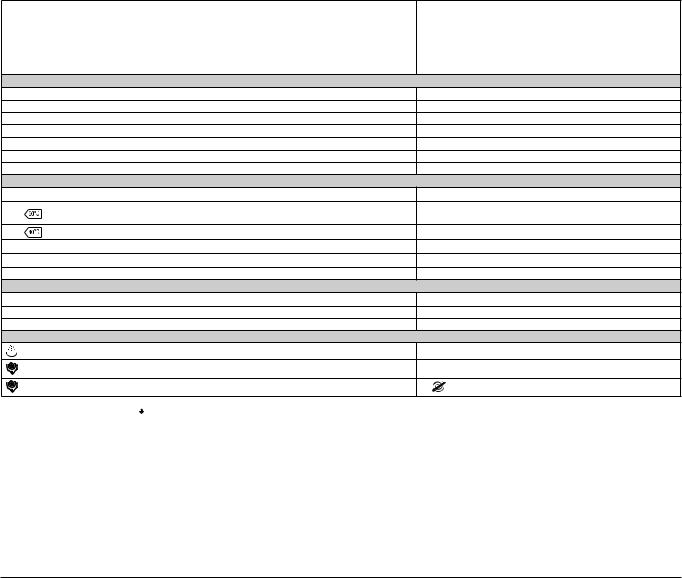
Programmes
|
|
|
|
|
Push & Wash |
||
FR |
|||
Cette fonction permet de lancer un cycle de lavage même si la machine est éteinte sans qu’il faille préalablement appuyer sur |
|||
|
|||
|
la touche ON/OFF ou, après allumage de la machine, sans avoir besoin d’activer aucune autre touche et/ou bouton (autrement |
||
|
le programme Push & Wash sera désactivé). Pour lancer le cycle Push & Wash appuyer 2 secondes de suite sur la touche. |
||
|
L’allumage du voyant signale que le cycle est lancé. Ce cycle de lavage est idéal pour le coton et les synthétiques grâce à une |
||
|
température de lavage de 30° et à une vitesse maximale d’essorage de 1200 tours/minute. Charge maximale 3,5 kg. (Durée |
||
|
cycle 50’). |
||
Comment fonctionne-t-il ?
1.Charger le linge (linge en coton et/ou synthétiques) et fermer le hublot.
2.Verser le produit lessiviel et les additifs.
3.Lancer le programme en appuyant pendant 2 secondes de suite sur la touche Push & Wash. Le voyant correspondant s’allume en vert et le hublot est verrouillé (symbole Hublot verrouillé allumé).
N.B. : Le démarrage du lavage à l’aide de la touche Push & Wash active un cycle automatique conseillé pour le coton et pour les synthétiques qui ne peut pas être personnalisé. Ce programme ne permet pas de sélectionner d’autres options. Pour ouvrir la porte tandis que le cycle automatique est en cours, appuyer sur la touche START/PAUSE ; si le symbole Hublot verrouillé est éteint, on peut ouvrir le hublot. Pour faire redémarrer le programme exactement à l’endroit de l’arrêt, appuyer une nouvelle fois sur la touche START/PAUSE.
4.A la fin du programme, le voyant END s’allume.
Tableau des programmes
Programmes |
|
Temp. max. |
Description du Programme |
(°C) |
|
|
|
|
|
Spéciaux |
|
|
|
|
1 |
Sportswear |
30° |
2 |
Foncé |
30° |
3 |
Anti-odeur (Coton) |
60° |
3 |
Anti-odeur (Synthétiques) |
40° |
4 |
Délicats |
30° |
5 |
Laine: pour laine, cachemire, etc. |
40° |
6 |
Duvet: pour linge et vêtements en duvet d'oie. |
30° |
|
Standard |
|
7 |
Coton 90°+P: blancs extrêmement sales. |
90° |
8 |
Coton Standard 60° (1): blancs et couleurs résistantes très sales. |
60° |
(Max. 90°) |
||
9 |
Coton Standard 40° (2): blancs et couleurs résistantes peu sales. |
40° |
10 |
Synthétiques: couleurs résistantes très sales. |
60° |
10 |
Synthétiques (3): couleurs résistantes peu sales. |
40° |
11 |
Couleurs |
40° |
|
Eco & Rapide |
|
12 |
Coton Standard 20°: blancs et couleurs résistantes peu sales. |
20° |
13 |
Rafraîchissement |
20° |
14 |
60’ Coton |
60° |
|
Fonctions |
|
|
Rinçage/Blanchiment |
- |
|
Essorage + Vidange |
- |
|
Vidange seulement * |
- |
|
|
|
* En cas de sélection du programme 
 et de suppression de l’essorage, la machine n’effectuera que la vidange.
et de suppression de l’essorage, la machine n’effectuera que la vidange.
|
Produit lessiviel et |
Charge maxi(Kg) |
Humidité résiduelle(%) |
Consommation d’énergie(kWh) |
totaleEau (lt) |
Duréecycle |
|||
|
Prélavage |
Lavage |
Adouciss Blanchiment |
||||||
Vitesse |
|
additifs |
|
|
|
|
|
||
maxi |
|
|
|
|
|
|
|
|
|
(tours |
|
|
|
|
|
|
|
|
|
minute) |
|
|
|
|
|
|
|
|
|
|
|
|
|
|
|
|
|
|
|
600 |
|
- |
|
|
|
|
|
- |
3,5 |
- |
|
- |
|
- |
|
55’ |
800 |
|
- |
|
|
|
|
|
- |
4 |
- |
|
- |
|
- |
|
70’ |
1000 |
|
- |
|
|
|
|
|
- |
3,5 |
- |
|
- |
|
- |
|
110’ |
1000 |
|
- |
|
|
|
|
|
- |
3,5 |
- |
|
- |
|
- |
|
100’ |
0 |
|
- |
|
|
|
|
|
- |
1 |
- |
|
- |
|
- |
|
80’ |
800 |
|
- |
|
|
|
|
|
- |
1,5 |
- |
|
- |
|
- |
|
70’ |
1000 |
|
- |
|
|
|
|
|
- |
2 |
- |
|
- |
|
- |
|
110’ |
1400 |
|
|
|
|
|
|
|
|
53 |
|
2,15 |
|
86 |
|
170’ |
|
|
|
|
|
- |
7 |
|
|
|
||||||||
1400 |
|
- |
|
|
|
|
|
- |
7 |
53 |
|
0,94 |
|
52,5 |
|
160’ |
1400 |
|
- |
|
|
|
|
|
- |
7 |
53 |
|
0,93 |
|
77 |
|
140’ |
800 |
|
- |
|
|
|
|
|
- |
3,5 |
46 |
|
0,79 |
|
46 |
|
110’ |
800 |
|
- |
|
|
|
|
|
- |
3,5 |
46 |
|
0,56 |
|
46 |
|
100’ |
1400 |
|
- |
|
|
|
|
|
- |
7 |
53 |
|
0,89 |
|
70 |
|
100’ |
1400 |
|
|
|
|
|
|
|
|
|
|
|
170’ |
||||
|
- |
|
|
|
- |
7 |
- |
|
- |
|
- |
|
||||
800 |
|
- |
|
|
|
|
|
- |
1,5 |
- |
|
- |
|
- |
|
20’ |
1000 |
|
- |
|
|
|
|
|
- |
7 |
- |
|
- |
|
- |
|
60’ |
1400 |
|
|
|
|
|
|
|
|
|
|
|
50’ |
||||
|
- |
|
- |
|
|
7 |
- |
|
- |
|
- |
|
||||
1400 |
|
- |
|
- |
|
- |
|
- |
7 |
- |
|
- |
|
- |
|
10’ |
|
|
- |
|
- |
|
- |
|
- |
7 |
- |
|
- |
|
- |
|
3’ |
|
|
|
|
|
|
|
|
|
|
|
|
|
|
|
|
|
La durée du cycle indiquée sur l’écran ou dans la notice représente une estimation calculée dans des conditions standard. Le temps effectif peut varier en fonction de nombreux facteurs tels que : température et pression de l’eau en entrée, température ambiante, quantité de lessive, quantité et type de charge, équilibrage de la charge, options supplémentaires sélectionnées.
1) Programme de contrôle selon la directive 1061/2010: sélectionner le programme 8 et une température de 60°C.
Ce cycle convient au lavage d’une charge de coton normalement sale et c’est le plus performant en termes de consommation d’eau et d’énergie, l’utiliser pour du linge lavable à 60°C. La température effective de lavage peut différer de la température indiquée.
2) Programme de contrôle selon la directive 1061/2010: sélectionner le programme 9 et une température de 40°C.
Ce cycle convient au lavage d’une charge de coton normalement sale et c’est le plus performant en termes de consommation d’eau et d’énergie, l’utiliser pour du linge lavable à 40°C. La température effective de lavage peut différer de la température indiquée.
Pour tous les instituts qui effectuent ces tests :
2)Programme coton long: sélectionner le programme 9 et une température de 40°C.
3)Programme synthétique long: sélectionner le programme 10 et une température de 40°C.
20

Personnalisations
|
|
|
|
|
Sélection de la température |
|
|||
FR |
||||
Appuyer sur la touche TEMPÉRATURE pour sélectionner la température de lavage (voir Tableau des programmes). |
||||
|
||||
La température peut être abaissée jusqu’au lavage à froid ( ). La machine interdira automatiquement toute sélection d’une |
|
|||
température supérieure à la température maximale prévue pour chaque programme. |
|
|||
! Exception: lors de la sélection du programme 8 la température peut être augmentée jusqu’à 90°. |
|
|||
Sélection de l’essorage |
|
|||
Appuyer sur la touche ESSORAGE pour sélectionner la vitesse d’essorage du programme sélectionné. |
|
|||
Les vitesses maximales prévues pour les programmes sont: |
|
|||
Programmes |
Vitesse maximale |
|
||
Coton |
1400 tours/minute |
|
||
Synthétiques |
800 tours/minute |
|
||
Laine |
800 tours/minute |
|
||
La vitesse d’essorage peut être réduite ou l’essorage supprimé en sélectionnant le symbole  . La machine interdira automatiquement tout essorage à une vitesse supérieure à la vitesse maximale prévue pour chaque programme.
. La machine interdira automatiquement tout essorage à une vitesse supérieure à la vitesse maximale prévue pour chaque programme.
Options
Les différentes options de lavage prévues par le lave-linge permettent d’obtenir la propreté et le blanc souhaités. Pour activer les options:
1.appuyer sur la touche correspondant à la option désirée;
2.l’allumage du voyant correspondant signale que la option est activée.
Remarque: Le clignotement rapide du voyant signale que la option correspondante n’est pas disponible pour le programme sélectionné.
 Anti taches
Anti taches
Cette fonction permet de sélectionner le type de sale de manière à adapter le cycle de façon optimale pour enlever les taches. Les types de salissure sont:
- Nourriture, taches d’aliments et de boissons, par exemple.
Nourriture, taches d’aliments et de boissons, par exemple.
- Travail, taches de graisse et d’encre, par exemple.
Travail, taches de graisse et d’encre, par exemple.
- Plein air, taches de boue et d’herbe, par exemple.
!La durée du cycle de lavage varie selon le type de salissure sélectionné.
!Cette fonction n’est pas activable avec les programmes 1-2-3-4-5-6-7-11-12-13-14- -
-
 .
.
 Fin du cycle rapide
Fin du cycle rapide
Pendant un programme de lavage, dans des conditions déterminées, la pression de cette touche permet de compléter, en cas de besoin, le programme de lavage en à peine 20 minutes, en procédant à un bref rinçage et à un essorage de 800 tours maximum ou inférieur s’il est réduit manuellement lors de la phase de personnalisation du programme. Dans ce cas la qualité du lavage et du rinçage sera réduite. Suite à la pression de cette touche, le voyant correspondant ainsi que le voyant indiquant la phase de rinçage s’allument. Au cas où la température sélectionnée est égale ou supérieure à 40° et que la touche est enfoncée pendant la phase initiale du programme, la durée de l’option «Fin du cycle rapide» est plus longue pour permettre au produit lessiviel de bien se dissoudre afin de ne pas endommager les textiles. Dans ce cas, seul le voyant de la phase de rinçage clignote tandis que le voyant du lavage reste fixe tant que les conditions d’activation nécessaires ne sont pas satisfaites. Au cas où la durée résiduelle du programme de lavage est inférieure à 20 minutes, l’option est désactivée.
! Cette fonction n’est pas activable avec les programmes 2-4-5-6-13-14- -
-
 .
.
 Repassage facile
Repassage facile
En cas de sélection de cette option, le lavage et l’essorage seront dûment modifiés pour réduire le froissement. En fin de cycle, le lave-linge fait tourner le tambour lentement, le voyant de l’option REPASSAGE FACILE et celui de START/PAUSE se mettent à clignoter, la phase END reste allumée en fixe. Pour compléter le cycle, il faut appuyer sur la touche START/PAUSE ou sur la touche REPASSAGE FACILE.
! Cette fonction n’est pas activable avec les programmes 1-3-5-13-14- -
-
 .
.
 Super Rinçage
Super Rinçage
La sélection de cette option permet d’augmenter l’efficacité du rinçage et d’éliminer totalement toute trace de lessive. Elle est très utile pour les peaux particulièrement sensibles.
! Cette fonction n’est pas activable avec les programmes 2-4-13-14-
 .
.
21
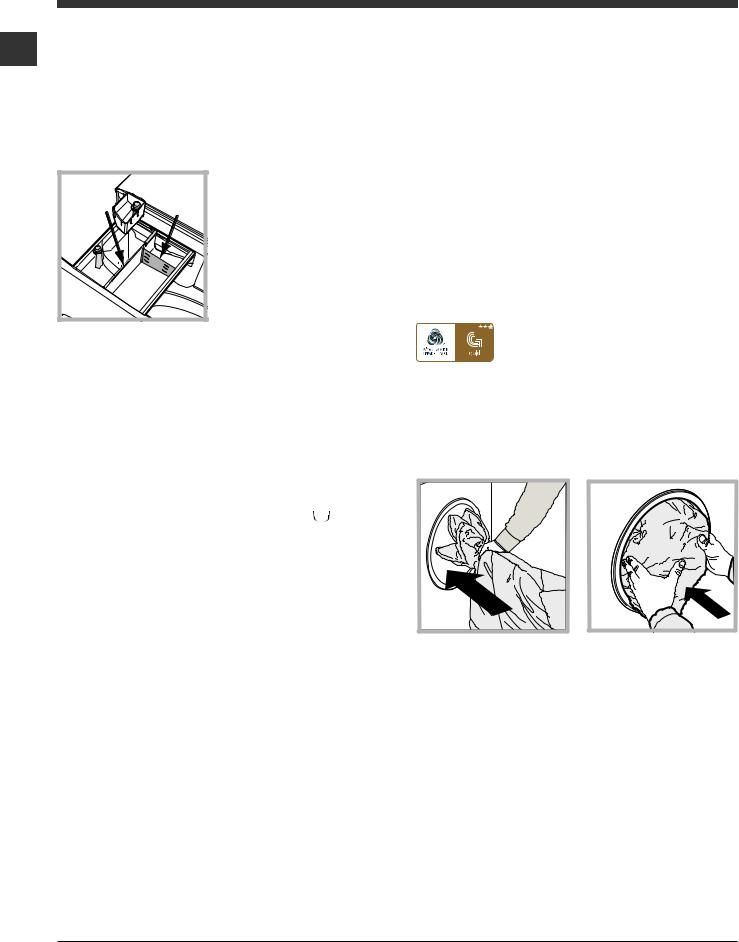
Produits lessiviels et linge
FR |
Tiroir à produits lessiviels |
||||
Un bon résultat de lavage dépend aussi d’un bon dosage |
|||||
|
|||||
|
de produit lessiviel : un excès de lessive ne lave pas mieux, il |
||||
|
incruste l’intérieur du lave-linge et pollue l’environnement. |
||||
|
! Ne pas utiliser de lessives pour lavage à la main, elles mous- |
||||
|
sent trop. |
|
|
|
|
|
! Utiliser des lessives en poudre pour du linge en coton blanc |
||||
|
et en cas de prélavage et de lavages à une température |
||||
|
supérieure à 60°C. |
|
|
||
|
! Respecter les indications figurant sur le paquet de lessive. |
||||
|
|
|
|
Sortir le tiroir à produits les- |
|
|
|
|
|
siviels et verser la lessive ou |
|
|
B 4 |
|
A |
l’additif comme suit. |
|
|
|
|
|||
|
|
1 |
|
Bac 1 : Lessive prélavage |
|
|
|
|
(en poudre) |
||
|
|
|
|
Avant d’introduire la lessive, |
|
|
3 |
|
|
s’assurer que le bac supplé- |
|
|
2 |
|
mentaire 4 n’est pas présent. |
||
|
|
|
|||
|
|
|
|
Bac 2 : Lessive lavage (en |
|
|
|
|
|
poudre ou liquide) |
|
En cas d’utilisation de lessive liquide, nous conseillons d’introduire le séparateur A fourni avec le lave-linge pour mieux
déterminer la dose correcte. En cas d’utilisation de lessive en poudre, placer le séparateur dans le bac B.
Bac 3 : Additifs (assouplissant, etc.)
L’assouplissant ne doit pas dépasser le niveau «max» indiqué sur le pivot central.
bac supplémentaire 4 : Javel
Cycle blanchissage
Monter le bac supplémentaire 4 fourni avec l’appareil à l’intérieur du compartiment 1. Au moment de verser l’eau de Javel, attention à ne pas dépasser le niveau « max » indiqué sur le pivot central. Pour effectuer un blanchissage, verser l’eau de Javel dans le bac supplémentaire 4 et sélectionner le programme 

 .
.
! N’utiliser de l’eau de Javel que pour les tissus blancs résistants et des détachants délicats pour les couleurs, les synthétiques et la laine.
Triage du linge
•Trier correctement le linge d’après :
-le type de textile / le symbole sur l’étiquette.
-les couleurs: séparer le linge coloré du blanc.
•Vider les poches et contrôler les boutons.
•Ne pas dépasser les valeurs indiquées correspondant au poids de linge sec : voir “Tableau des programmes”.
Combien pèse le linge ?
1 drap 400-500 g
1 taie d’oreiller 150-200 g
1 nappe 400-500 g
1 peignoir 900-1200 g
1 serviette éponge 150-250 g
Linge ou vêtements particuliers
Sportswear (programme 1) est spécialement conçu pour laver des textiles propres aux vêtements de sport (survêtements, shorts, etc.) peu sales ; pour obtenir d’excellents résultats nous recommandons de ne pas dépasser la charge maximale indiquée dans le “Tableau des programmes”. Nous recommandons d’utiliser de la lessive liquide, avec une dose appropriée pour une demi-charge.
Foncé: utiliser le programme 2 pour le lavage des textiles de couleur foncée. Ce programme est conçu pour préserver les couleurs foncées au fil des lavages. Pour obtenir de meilleurs résultats, nous conseillons d’utiliser de la lessive liquide spéciale textiles foncés.
Anti-odeur: utiliser le programme 3 pour laver le linge et le débarrasser des mauvaises odeurs (par ex. tabac, transpiration, friture). Ce programme est conçu pour éliminer les mauvaises odeurs tout en préservant les fibres des tissus. Il est conseillé de laver à 40° les textiles synthétiques ou les charges mixtes et à 60° les tissus de coton résistant.
Délicats: utiliser le programme 4 pour le lavage de textiles très délicats. Il est recommandé de mettre les vêtements à l’envers avant de les charger dans le lave-linge. Pour obtenir de meilleurs résultats, nous conseillons d’utiliser de la lessive liquide spéciale textiles délicats. Pour le lavage des pièces en Soie et des Rideaux, sélectionner le cycle 4 et activer le option  ; à la fin du cycle, la machine s’arrête en laissant le linge tremper et le voyant se met à clignoter. Pour vidanger l’eau et pouvoir sortir le linge, il faut appuyer sur la touche START/PAUSE ou sur la touche
; à la fin du cycle, la machine s’arrête en laissant le linge tremper et le voyant se met à clignoter. Pour vidanger l’eau et pouvoir sortir le linge, il faut appuyer sur la touche START/PAUSE ou sur la touche  .
.
Laine: le cycle de lavage « Laine » de ce lave-linge a été testé et approuvé par la société Woolmark Company pour le lavage d’articles contenant de la laine classés comme « lavables à la main », à condition que le lavage soit effectué conformément aux instructions indiquées sur l’étiquette du vêtement et aux indications fournies par le fabricant de ce lave-linge. (M1126)
Duvet: pour laver des articles avec garnissage en duvet d’oie comme par exemple des couettes pour une personne (poids maximal à ne pas dépasser 2 kg), oreillers, anoraks, utiliser le programme spécial 6. Pour introduire les duvets dans le tambour, nous recommandons de replier les bords en dedans (voir figures) et de ne pas occuper plus de ¾ du volume du tambour. Pour un lavage optimal, nous recommandons d’utiliser une lessive liquide à doser dans le tiroir à produits lessiviels.
Couleurs: utiliser le cycle 11 pour le lavage de textiles de couleur claire. Ce programme est conçu pour préserver l’éclat des couleurs au fil des lavages.
Coton Standard 20° (programme 12) idéal pour des charges de linge sale en coton. Les bonnes performances, même à froid, comparables à celles d’un lavage à 40°, sont assurées grâce à une action mécanique qui brasse en variant la vitesse et avec des pics répétés et rapprochés. Rafraîchissement (programme 13) cycle idéal pour rafraîchir du linge peu sale en quelques minutes.
Il ne dure que 20 minutes et permet ainsi de faire des économies de temps et d’énergie. Il permet de laver ensemble des textiles différents (sauf laine et soie) avec une charge maximum de 1,5 kg.
60’ Coton (programme 14): le cycle 60’ est conçu pour laver à 60° en une heure du linge en coton résistant moyennement sale avec une bonne performance de lavage. Pour les synthétiques ou les textiles mélangés, nous conseillons d’abaisser la température à 40°.
22
